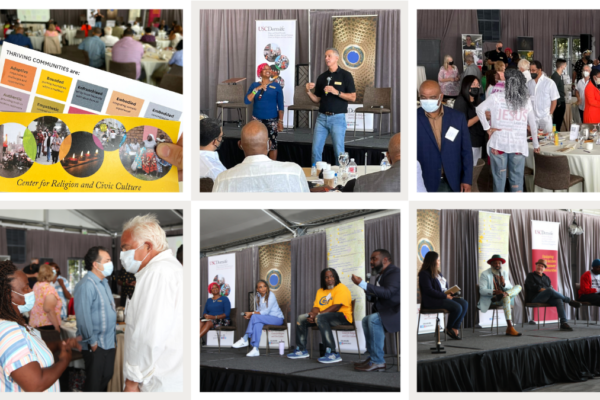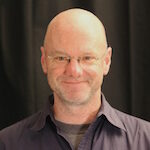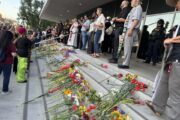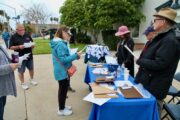The USC Center for Religion and Civic Culture (CRCC) recently held its first in-person event since the start of the COVID-19 pandemic in late 2019. More than 70 clergy and faith-inspired community leaders met in an airy space at the Hotel Maya in Long Beach for a half-day conference to discuss the challenges and lessons of the pandemic–and simply to gather, mindful of public health precautions, to share stories and fellowship after a long period of isolation.
Before the start of the morning session, Maria Socorro Castro and Adrienne Hament, lay leaders at St. Ignatius of Loyola Church in northeast Los Angeles, spoke to CRCC about the challenges their parish had faced over the past two years. Membership was stable before the pandemic–the nationwide trend toward religious disaffiliation is less apparent in the Latino and Filipino communities served by the parish. But the health crisis, coupled with economic hardship and constraints on public gatherings, upended the parish’s organizational model.
“With fewer people coming to church”–where parishioners were used to making in-person tithes and offerings–“we had to be more focused on finances, donations and operating expenses,” Castro said.
Hament added that the parish had to ramp up some of its outward-facing ministries even as it was retooling its internal operations.
“People lost jobs because of the pandemic,” she said. “There was food insecurity in the community, and more people had to look for free resources.”
Still, most conference participants were upbeat, even if many congregations had experienced loss and hardship during the pandemic.
“We work with a lot of pastors,” said Zach Ellis, a youth ministry trainer at the Fuller Youth Institute in Pasadena. “And we’ve seen a lot of creative ideas–things that wouldn’t have happened if COVID hadn’t happened. Youth and young adults have taken the lead in that.”
Shehib Taylor, a lay leader at New Antioch Church of God and Christ in South Los Angeles, echoed Ellis’ optimism in the face of adversity.
“We’ve had to dig deep to come up with innovative ways to keep our current members and attract new members,” Taylor said, noting that generational divides over technology, as well as declining religious affiliation more generally, were challenges even before the pandemic.
“These issues have been there for years,” he added. “Now there’s more urgency. The key thing to realize is that we’re not the only source for solutions. We have to ask, what can we all do collectively?”
Rev. Najuma Smith-Pollard–CRCC’s assistant director of community and public engagement, who moderated the conference’s two panels–summed up that call to collaboration by highlighting a remark from Pastor Shep Crawford, one of the panelists: “We’ve learned that what happens on Sunday morning isn’t the headliner–it’s the opening act.”
The fact that churches and other worship spaces must become more than once-a-week entertainment venues if they hope to survive has been apparent to Richard Flory, CRCC’s executive director, for more than two decades. Summarizing his years of research on religious change and congregational life, he told the audience that the current climate of political and social polarization is as great a challenge for congregations as the long-running trend of religious disaffiliation and the more recent, pandemic-related limitations on public gatherings.
Nonetheless, he found reason for optimism in the eagerness of conference attendees–including Muslims, Jews, Protestants and Catholics–to work collaboratively on issues of common concern.
“We’re calling the conference ‘Reimagining’ because, in some ways, the pandemic was a reset,” he said, noting that everyone in the room was asking, “How can we transform challenges into opportunities?”
Flory connected that driver of transformation to findings presented at CRCC’s 2017 conference on religious creativity and innovation. He then highlighted four main characteristics of congregations that have managed to thrive in increasingly complex and rapidly changing social environments:
- adaptive programs and processes that incorporate members into the formation of the congregation’s identity and mission
- openness to rituals and practices within the congregation’s tradition that support individual spiritual experience and development
- willingness to put their beliefs and commitments into action to serve the community
- a “learning organization” culture that seeks knowledge and cooperation from other organizations doing similar work.
The day’s panelists, guided by Rev. Smith-Pollard, described what putting those principles into practice had looked like during the pandemic.
“Churches really struggle with mental health,” said Shalonda Crawford, a psychotherapist and pastor with The Experience Christian Ministries. Crawford noted that responding to the traumas of the pandemic had prompted her congregation not only to look inward to care for its own members, but also to look beyond “the four walls” to respond to needs in the surrounding community.
“If your church is in a community that doesn’t know you’re there, you haven’t covered the basics,” she said. She noted that over the course of the pandemic, her congregation had reached out to local elected officials, the parks and recreation department, police and other faith leaders.
“We know the OGs in our community,” she added.
Geremy Dixon, pastor at Center of Hope in Inglewood, deconstructed the megachurch model of congregational growth and found it inadequate for meeting the challenges of the pandemic.
“In the last decade,” he said, “it felt like a lot of churches were just focusing on lights and smoke and colorful spaces for kids. COVID reoriented people. They said, ‘No smoke today, no LED lights’.”
In describing the reorientation of his own thinking during the pandemic, Dixon contrasted the “gathering” and “tethering” aspects of congregational life. Gathering is the activity that most people associate with church. That inward focus is necessary, he said, yet churches function optimally when the boundaries between the congregation and the wider community are more porous–when the church is more like a tether that allows its members to collaborate and “cross-pollinate” with other groups that want to serve the local community.
“We had a limited view of what it meant to be organized,” Dixon said. He now realizes that, with the more expansive view of his church’s organizational mission compelled by the pandemic, “That includes doing economic development–helping people manage their own destiny.”
Umar Hakim, executive director of the Intellect Love Mercy (ILM) Foundation, has baked collaboration and economic development into ILM’s annual Humanitarian Day event, which began as an initiative to provide wraparound services to unhoused people living on Skid Row in downtown Los Angeles. Twenty years after the first Humanitarian Day, which is scheduled during the holy month of Ramadan on the Islamic calendar, the event now draws interfaith volunteers to provide services to communities in Oakland, San Bernardino, Pomona and Santa Ana in addition to Skid Row.
“As we have discovered during the pandemic, no one can do it by themselves,” he told conference participants. “Power is the product of relationships. Our partners are all communities that favor the work that we do.”
Hakim’s hope for the future elicited nods of recognition from his audience: “I want to exit the pandemic better than I went into it,” he said.
Many of the challenges exposed or exacerbated by the pandemic persist–food insecurity, political polarization, gun violence and deficits in mental health care remain obstacles to progress in many communities. Yet, for many faith-based community organizations, these crises have presented opportunities for innovation. We at CRCC will continue to encourage that forward momentum and to help such congregations thrive.
Read the LA Sentinel’s coverage of Reimagine (Again)
Nick Street was a senior writer with the USC Center for Religion and Civic Culture.








